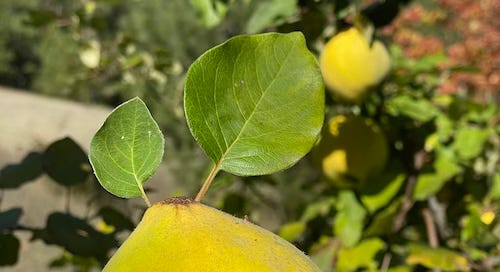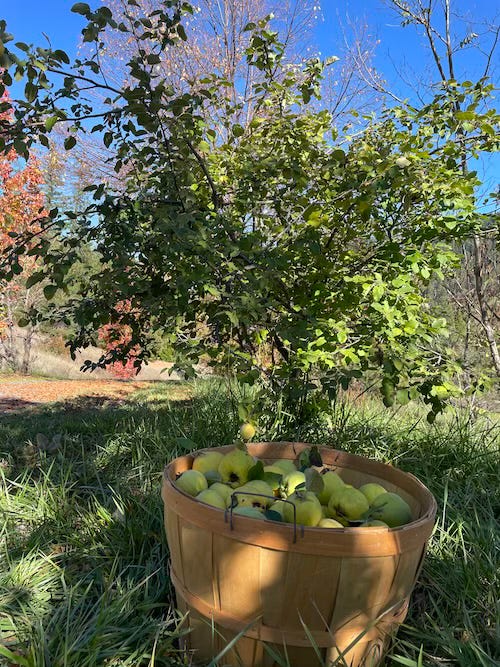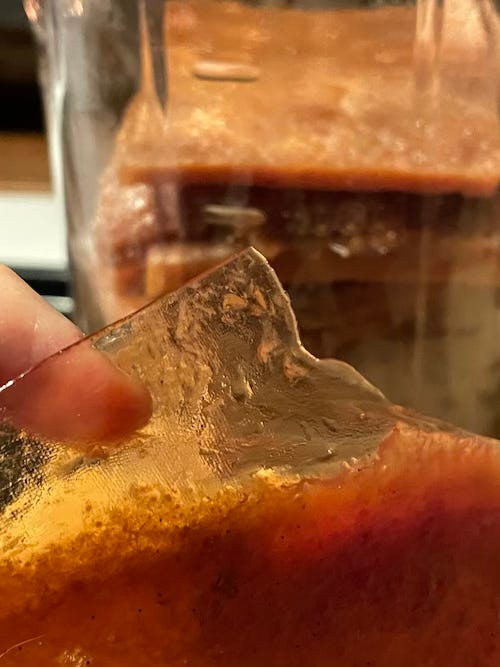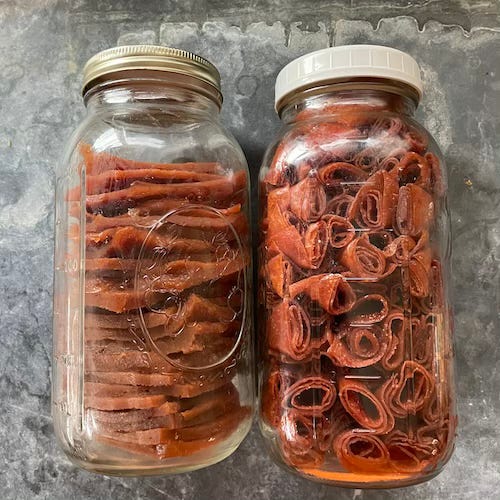Q is for Quince
Meet quince--fermented or cooked--it is a healthy fun fruit to add to your world, weekend scrolls and gift ideas
A few days before 15 people were to descend for a Thanksgiving meal, I decided to preserve our quince harvest. At that moment it seemed like perfect timing. I had a bushel basket of quince that was attracting fruit flies. We’d picked the quince some weeks before from the tiniest tree. I planted this tree around six years ago because one of our sons loves quince. Each year the tree seems to stay the same size while the harvest increases two-fold. This year the amount of fruit made by this tree seemed to defy some law of nature. And I imagined a delicious quince paste as part of our meal.
If you haven’t met quince (Cydonia oblonga) it is an ancient fruit you may (or may not) see in the produce section in fall, near the apples and pears, of which it is a botanical cousin. It looks like a badass pear — tougher, a little misshapen, and larger, with sunny, vibrant-yellow skin that is often a bit blemished and sometimes slightly fuzzy. The thing with quince is it isn’t for eating raw. It is hard, harder than a fresh cold Granny Smith apple, biting into it is at first grainy and then astringent (dries out the inside of your mouth.) Unlike other astringent fruit, like persimmons, no amount of waiting and ripening, or bletting, will make them delicious raw.
The whole fruit is high in pectin—skin, flesh, seeds. Unlike apple or pear seeds, quince seeds have a notable list of health benefits some of which include reducing inflammation and as gut support. Gut support isn’t a surprise as often mucilaginous foods are remarkable for our digestive system. Common examples are slippery elm bark and natto.
As it is with small, delightful synchronicities, I was reading The House on Sun Street by Mojgan Ghazirad when I was working with the quince. I love it when authors share tiny tidbits of cultural food knowledge within the words of their stories. The novel is a coming-of-age story that takes place in Iran during the Islamic Revolution.
“Behdooneh is good for your cough,” Azra told Reza. She poured boiling water into a tall glass half-filled with the quince seeds. The seeds gave away a gelatinous juice that thickened the water…”
This gelling is my experience with the seeds, however, using them as a soothing tea is just the type of information I like to tuck away. Because now we can, I googled Behdooneh, and found this post, which had a picture of a packet of seeds to buy. I found that quince seeds are available from a store specializing in Mediterranean and Persian ingredients. Quince is native to the area that is now Iran and Turkey which accounts for its long history with both culinary and medicinal applications.
When I am preparing for these posts I often start by researching fermentation and the ingredient I am highlighting. When I looked for scientific papers on quince and fermentation I found one that intrigued me because again it pointed to the seed. The scientists, who are from Iran, asked the question – could the mucilage from quince seeds act as a coating material to protect the probiotic Lactobacillus rhamnosus of a dairy-based dessert when it was exposed to heat during packaging?
Their conclusion was yes, they successfully encapsulated the L. rhamnosus and it proved to protect the viability of these probiotics up to 72°C.
Back to my kitchen…
I decided to make membrillo. Membrillo, often called a quince cheese, is a sweet light brownish-red jelled paste. It is firm and cuts like cheese and is often served with cheese in Spain and Latin American countries. You make membrillo-like jam--by uniting fruit and sugar with heat and time. For membrillo you keep the heat lower and the time longer. As the water in the fruit steams off the flavors concentrate and the paste becomes a deep color with an almost tropical-scented fruity perfume. Once thickened it is cooled in shallow vessels and cut into bricks or wedges. I am not one for sweets, but I do like this confection which pairs so beautifully with savory, salty things, of which I am a huge fan.
I have never made membrillo and followed a recipe I found on the internet that advised removing seeds and skin. (As an aside, I used the skins for scrap vinegar and the next morning it was quite gelatinous. So I unwittingly removed much of my pectin. The skin is also high in good fiber and many valuable nutrients and research is being done to use the peels in novel ways to help eliminate that food waste.)
My membrillo on the other hand was not gelling. I spent the next few days letting it cool, then because it was so thick letting it sit overnight (likely small fermentations happened during these rest periods) and heating it and stirring often in hopes of thickening it enough. I baked it in a very low oven as the recipe suggested. This was never going to help. There simply was not enough pectin. This did not magically solve the problem of what was a quince butter—delicious but not my vision—and waaaaay too much. Had I mentioned that I had 3 ½ gallons of quince mash? And I need to reclaim my stove the next day was Thanksgiving.
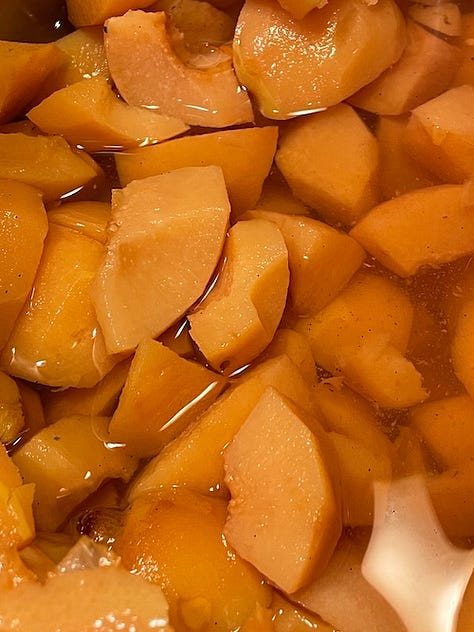
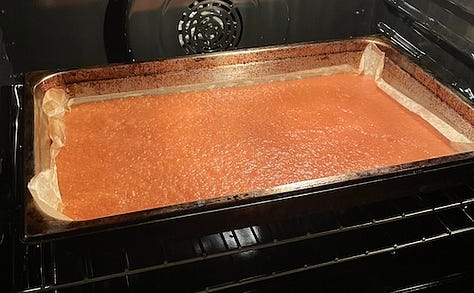
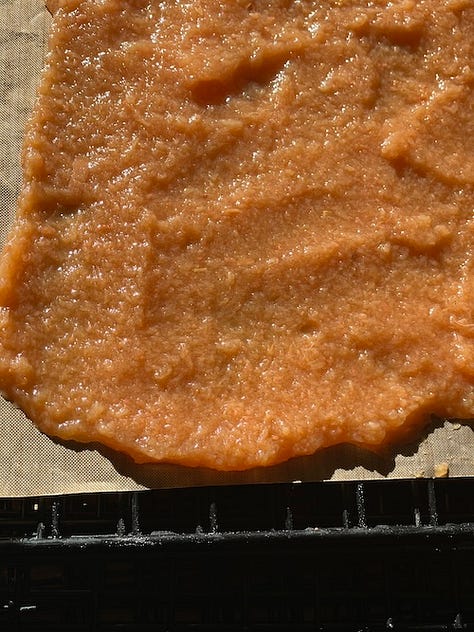
I dehydrated some as fruit leather and some I spread as thick as I could hoping to get a membrillo-like fruit cheese.
What about Fermentation?
Generally, when I ferment with quince I use the raw fruit, slice it thinly, and add it to any number of makes. The prebiotic fiber in quince is fully intact when raw. Quince becomes edible as a raw ingredient with fermentation. Though, I find that it doesn’t have that delicious rose perfume that quince is known for. I have also quickly heated it to bring out those delicate aromas. Depending on the accompanying ingredients the flavors will hold through fermentation. It depends on what I am aiming for in the final make regarding texture and flavor. I like to think of understanding an ingredient making it possible to ferment intuitively.
In this week’s paid post I share more, including a video showing how to use quince in kimchi.
Just for fun…weekend scrolls
🍹 Fermentation fermentation cocktail. This Old Fashioned recipe used a miso simple syrup and koji fermented whiskey.
🍺 Rogue Creamery is local to my area, and I have to say their blue cheese is amazing. I have not had Central Oregon’s Crux Fermentation Project beer. I love that they created a mobile brew tank called the Coolship. Apparently, I missed its local appearance at Rogue Creamery where they added blue cheese to the tank…
Holiday Gifts for the fermenter in your life
A gift subscription to Ferment Nerds
Fermentation Books This shop has some of my favorites as well as my own titles.
Courses at The Fermentation School


